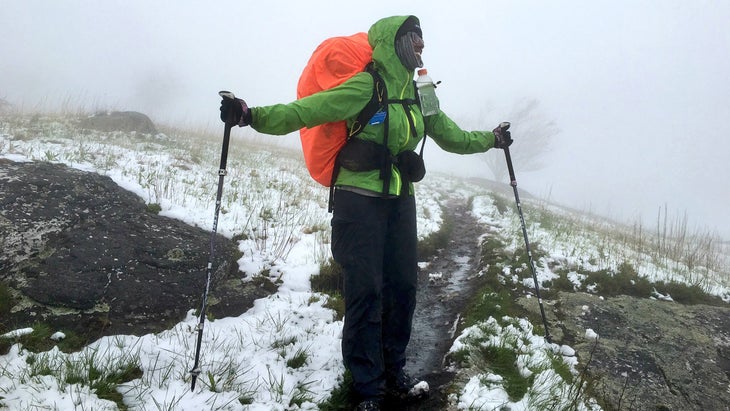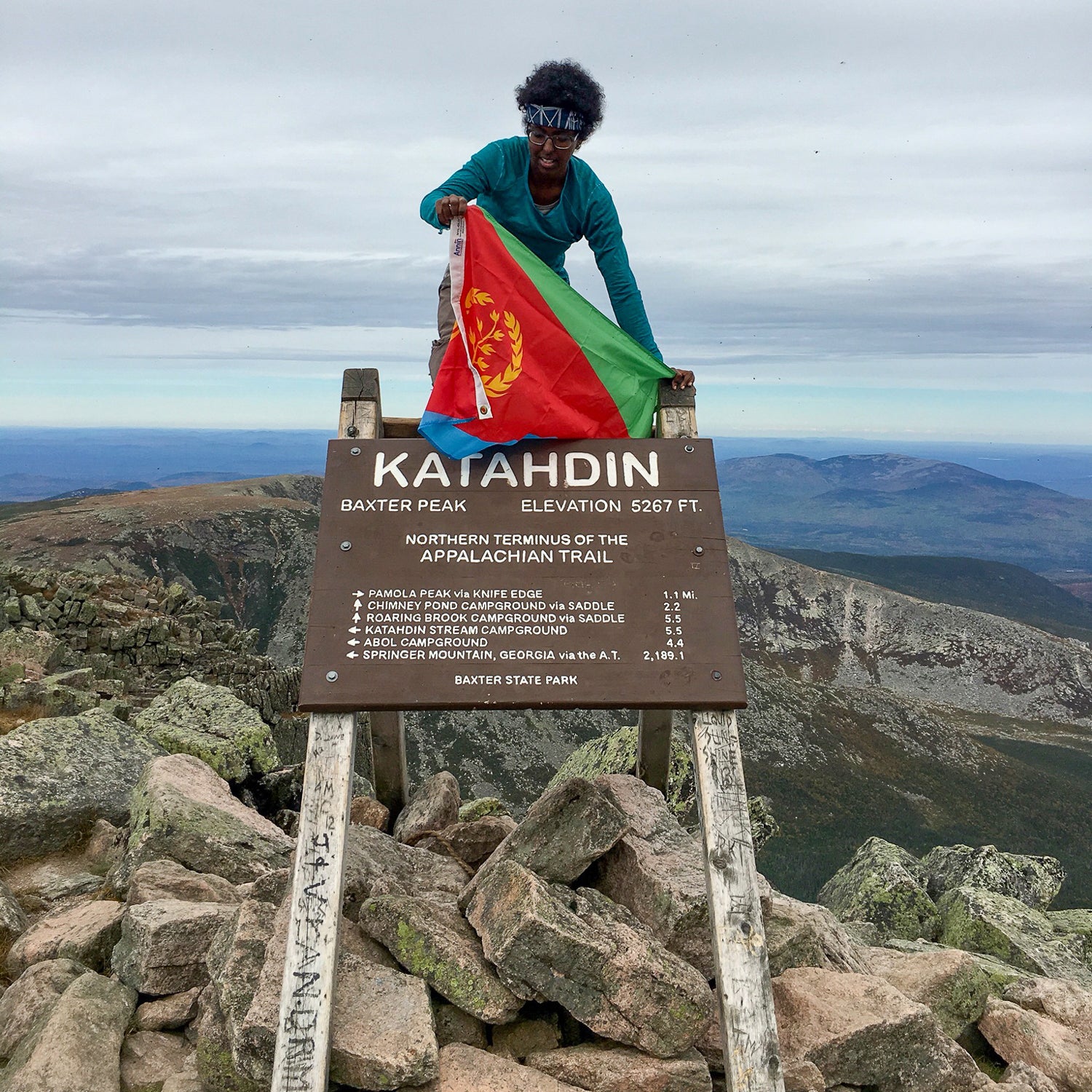This story update is part of the ���ϳԹ��� Classics, a series highlighting the best writing we’ve ever published, along with author interviews and other exclusive bonus materials. Get access to all of the ���ϳԹ��� Classics when you sign up for ���ϳԹ���+.
In 2016, in the leadup to one of the most contentious presidential elections in history, writer Rahawa Haile set out from the Approach Trail at Amicalola Falls, in Georgia, to hike the Appalachian Trail, which stretches 2,139 miles up to Mount Katahdin, Maine. Rahawa planned to hike it as a single woman alone, which was daunting enough. But she is also Black and queer, two qualities that put her firmly in the minority on the trail. Nonetheless, she whittled her possessions down to 14 boxes and a cat, parked the boxes and the cat with friends, and started walking.
Haile’s six-month journey was filled with hardship and beauty, not to mention exhaustion, foot pain, and one too many bowls of Idahoan Instant Mashed Potatoes. On the trail, she experienced the tight community of thru-hikers and the healing grace of trail angels. In towns off the trail, she passed dozens of Confederate flags and was once followed by store employees when she went in to resupply.
Going It Alone
What happens when an African American woman decides to solo-hike the Appalachian Trail from Georgia to Maine during a summer of bitter political upheaval? Everything you can imagine, from scary moments of racism to new friendships to soaring epiphanies about the timeless value of America’s most storied trekking route.Her May 2017 story, “Going It Alone,” took off on social media, inspiring countless new hikers and opening up an ongoing conversation about race and identity in the outdoors. Since she finished the AT, Haile, 36, has hiked the High Sierra Trail and the Selma to Montgomery National Historic Trail, retracing the steps of John Lewis and his fellow civil rights marchers in 1965. She lives in Oakland, California, where she is at work on In Open Country, her memoir of hiking the AT as a Black woman in one of the most volatile summers in American history. Look for it from HarperCollins in 2023. In the meantime, keep up with her on Twitter .
Contributing editor Elizabeth Hightower Allen caught up with Haile in Miami, where she was visiting family, to find out what scared her the most on the trail, the one piece of gear she couldn’t live without, and why thru-hiking is always worth it in the end.
OUTSIDE: I have to start by saying, your story just really made me want to hike the Appalachian Trail.
HAILE: Oh, that’s wonderful to hear. I can’t tell you how many people, especially Black people, tell me, Wow, that made me never want to hike the trail. And my heart breaks into a million pieces. I don’t blame them—thru-hiking is a hard and exhausting and repetitive endeavor. But I still hope there was enough in the story to make people realize just how wondrous the AT can be.
How did you get the idea to hike the whole thing?
I grew up in Miami, which is famously flat. But when I moved to New York after college, I struggled to get outside. I remember trying to figure out, What do people do up here? It turns out people hike up mountains. A friend took me hiking on Bear Mountain, and I remember following those white blazes. I know about the Appalachian Trail, obviously—probably from Bill Bryson’s book A Walk in the Woods—but I didn’t realize I was hiking on it until we reached the summit.
The thought of doing that all the way from Georgia to Maine was compelling. I was newly single and I profoundly hated my day job at a title insurance company, so I decided to seize the day while I was mortgage-free and child-free. It felt good in my heart. I don’t know about you, but that feeling is not as frequent as I would like, and so it’s wise not to pass it up when they come your way.
You were also grieving the loss of your maternal grandmother. She grew up in Eritrea, and you wrote beautifully in the story about how she used to talk about tuum nifas—a delicious wind—when you were out on walks in South Florida. I wondered if her delight in being in the elements prepared you for some of the discomfort on the trail.
I never stopped thinking of her. She’s always with me, but especially outside and in nature. My family loves being outside together. My parents moved to Florida from Eritrea in 1975, as refugees from the .��Asmara, Eritrea, is at 7,600 feet, and very dry. I’m trying to imagine them arriving in what was essentially Jurassic Park, and being filled with wonder.
Also, there is nothing like South Florida to prepare you for discomfort. I say that not as an insult, but as a point of pride. When you’re young, you don’t mind the humidity or the mosquitoes—all�� you care about is that you’re doing something exciting.
I want to talk about your experiences on the trail, good and bad. But first, let’s get all Cheryl Strayed and Wild: what did you pack?
For somebody with an anxiety disorder who has very little experience hiking in mountainous areas, I will tell you that researching gear became a mini-obsession. Finding the best deals for the warmest and lightest stuff was a year-long mission.
I did this shakedown hike over Thanksgiving. I thought, This is great—I have a long weekend, I can take the Metro North to the Appalachian Trail stop and do a few nights. However, I had not considered two words: hunting season. I completely lost the trail and it was 40 degrees and raining, and gunshots were going off around me. I had this moment where I thought, Okay. If I can get out of here alive, I’m pretty sure I could do the whole trail.
Since this is ���ϳԹ���, we have to ask: what was your gear MVP?
My wool buff! It kept me warm through the night; it kept me dry when I showered in a random hostel and there were no towels; it wiped my tears away. It wiped up blood when I banged my shins. It’s a security blanket at this point.
Food?
The thing I craved more than anything when I got to a town was chocolate milk. I could just guzzle it. On the trail—oh god, . I do understand that they’re intended to be a side dish for four people, but still, they hit the spot. They’re just the best.
And, of course, your trail name. What did people call you?
People tried to call me a bunch of things, but we’ll save that for later. I had an orange pack cover, and hikers told me it looked like they were following the sun. Someone suggested Sunny, but it seemed like there were 6,000 Sunnies out of 5,000 thru-hikers on the trail that year, and I didn’t want to be Sunny #429. But I am from Florida and I do love the sun, so I chose the name Tsehay, which means sun in Tigrinya, the language my family speaks.
Did you find yourself walking alone, or did you have a sidekick, like Bill Bryson?
Does pain count? Pain was my sidekick—you know, just my foot pain and me, splitting a Snickers bar. I’d have to pause roughly every five miles to roll my feet on a lacrosse ball. Everybody on the trail has a weak part that gives out by the end of the day—their backs, their knees. For me, it was foot pain.
I did fall into trail families for a hundred or two hundred miles, but for the most part, I hiked on my own. It’s a wonderfully freeing but also terrifying proposition to be alone with your thoughts for six months. There was a lot of breaking down and bawling. You just confront every version of yourself you’ve ever been, or never had a chance to be. It’s a beautiful thing, but it’s also so hard. So very hard.

Had you set out to write about the journey?
I told my agent, Listen, I’m going on a six-month hike, and I don’t know how far I’ll get—seriously, my first goal was just getting through the Smokies. But it was 2016, and the country was potentially about to elect a certain president, and I wanted to experience it before whatever followed.
Eventually, when I got halfway through the Smokies, to Gatlinburg, Tennessee, I I saw in a general store. ���ϳԹ���’s editorial director, Alex Heard, saw it and asked if I’d be interested in writing about my trip. I had to say, I am 200 miles into a 2,000-mile hike, but should I get far enough, I would love to. So, it’s not like ���ϳԹ��� hired me as a reporter—they sent me a camp pillow, and that was the extent of my gear support.
We could do better than that!
No, no—that was all I asked for!��
So here you are in rural Tennessee, surrounded by Confederate flags and firework shops. When you started out, were you most worried about being a woman alone, a Black woman alone, or a queer woman alone? I’m thinking of the violence against queer women hikers in the past.
Well, I am a queer Black woman, but I can’t parse the three—they’re not three separate parts of my identity. But it felt like a vulnerable position. There were so many targets on my back, but I stood out most as a Black thru-hiker. There were many women on the trail but very few Black people.
My other huge concern was Lyme disease. I was terrified of getting bit by a tick. So, yeah, my two biggest worries were hate crimes and deer ticks.
Did the environment around race ease up the farther north you went?
Oh, absolutely not. The Confederate flags did not stop. I remember reaching the Mason-Dixon line. The moment I crossed into Pennsylvania, it was nothing but Confederate flags. The tension was everywhere. It truly went all the way to Maine. I don’t know that there’s safety anywhere in this country for us—whether you’re driving while Black, barbecuing while Black, or running or birding while Black.
I knew what to expect from Gatlinburg: my motel key had an advertisement for Dolly Parton’s Dixie Stampede, before they dropped “Dixie” from the name. But there were microaggressions the entire way up. I remember being followed around a store by employees when I resupplied later in the hike.
But this was in the towns. Mostly the Appalachian Trail community itself was really supportive. That’s the thing that’s hard for people to see: just how much people are looking out for each other. I know there were people looking out for me.
Tell me about that community. You stumbled across an almost magical congregation of trail angels on the Tennessee-North Carolina border.
I’d just come off a harrowing descent of Snowbird Mountain, and there was lightning everywhere. I slid down the trail more than I walked. The mud and the rain were so cold. That night, I crawled into my tent and collapsed. There was a lot of crawling in and collapsing in the early days.
But the next day was this perfect clear day, and I hiked over Max Patch, one of the most scenic areas of the entire trail. I ran into another Black hiker named Hazelnut, and it helped me feel less alone, if only for a little bit.
Below Max Patch, there was a reunion of thru-hikers. They’d brought tons of food and set up a dozen chairs around a campfire to feed hikers. I have a hard time believing that I will ever have a spa experience that is more healing. Probably 18 of 19 people said that they’d come out on the trail to heal from any number of things—military service, relationships, loss, cancer. Everybody was looking for a way to get back to some kind of homeostasis, trying to do their best and taking it one day at a time.
This theme comes through a lot in the story—that the AT is first a community of hikers, not of white men or Black women or Republicans or Democrats. As we strive for more inclusivity in the outdoors, is the end goal that we’re all just hikers?
No, I don’t think that the end goal is that we’re just hikers. I will never just be a hiker in this world, in this country, and so I don’t think I could ever just be a hiker on the trail. I will say that the explosion in outdoor affinity groups has had a big impact on welcoming people who were curious and inexperienced and have come to realize they aren’t alone. But so many of these affinity groups revolve around the ability to organize and be in community, and that’s been compromised severely during the pandemic.
I know that my hike and those of other women of color have inspired others, but that doesn’t affect systemic change. I take it for what it is. I’m always so thrilled to get messages from people who say, Hey this made me feel less alone or You inspired me to go on my first day hike. And I truly am grateful. But what I want is the impossible, and that is for all people to be safe outdoors. It’s not like the trail or the outdoors is this magical place separate from the rest of the country. There’s a lot of work ahead.
You’ve written that some of your , like Zora Neale Hurston. What do you hope that your book will offer people who need a friend?
I definitely hope it’ll offer them companionship. I hope it’ll offer them language for some of the feelings they haven’t fully processed, and tell them that it’s not in their heads, that they’re not alone. But really the book uses the trail as the spine and then branches off into any number of things—Native American history, climate change, borders, freedom of movement. I definitely come out guns blazing. I do not pull my punches.
I have one more question: What happens when you get off the trail? I think this is a universal question everyone grapples with after such a long, meaningful adventure. How do you keep the clarity and joy you felt among your peers in the wilderness?
Right!? I write in the book that the Appalachian Trail can save you, but it cannot save you indefinitely. It’s work to hold on to that clarity. It is work to keep yourself open. You go from disappearing from the realities of existence in this country to being bombarded by them—in my case, with a singular election three weeks after I finished.
The election changed things. In 2017, nobody asked me why I went to the woods. If anything, they asked how to do it. People wanted to escape. The past five years have been extremely traumatizing and downright depressing and life-shattering for many people.
I will say that people who returned from the trail to lives where they were surrounded by family or a job they loved handled it better than people who had to figure everything out. You go from knowing exactly what you’re going to do every single morning to being completely lost. If I have advice to anyone, it’s to let the people closest to you know you’re going to need them. It isn’t like a hero’s journey, where the world continues to celebrate you. You need to work toward your own joy.


